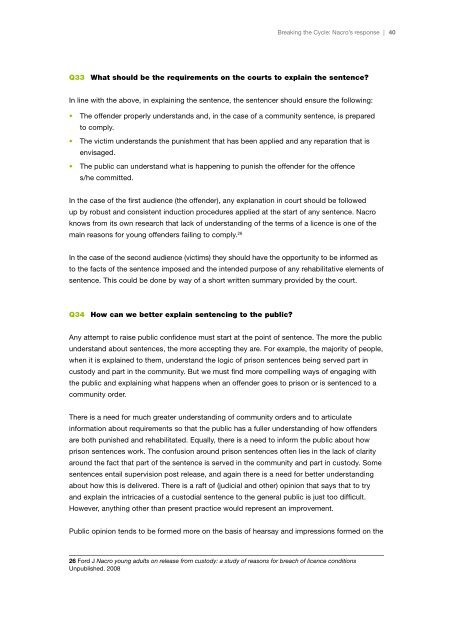Nacro's response to Breaking the Cycle Green Paper
Nacro's response to Breaking the Cycle Green Paper
Nacro's response to Breaking the Cycle Green Paper
Create successful ePaper yourself
Turn your PDF publications into a flip-book with our unique Google optimized e-Paper software.
<strong>Breaking</strong> <strong>the</strong> <strong>Cycle</strong>: Nacro’s <strong>response</strong> | 40Q33 What should be <strong>the</strong> requirements on <strong>the</strong> courts <strong>to</strong> explain <strong>the</strong> sentence?In line with <strong>the</strong> above, in explaining <strong>the</strong> sentence, <strong>the</strong> sentencer should ensure <strong>the</strong> following:• The offender properly understands and, in <strong>the</strong> case of a community sentence, is prepared<strong>to</strong> comply.• The victim understands <strong>the</strong> punishment that has been applied and any reparation that isenvisaged.• The public can understand what is happening <strong>to</strong> punish <strong>the</strong> offender for <strong>the</strong> offences/he committed.In <strong>the</strong> case of <strong>the</strong> first audience (<strong>the</strong> offender), any explanation in court should be followedup by robust and consistent induction procedures applied at <strong>the</strong> start of any sentence. Nacroknows from its own research that lack of understanding of <strong>the</strong> terms of a licence is one of <strong>the</strong>main reasons for young offenders failing <strong>to</strong> comply. 26In <strong>the</strong> case of <strong>the</strong> second audience (victims) <strong>the</strong>y should have <strong>the</strong> opportunity <strong>to</strong> be informed as<strong>to</strong> <strong>the</strong> facts of <strong>the</strong> sentence imposed and <strong>the</strong> intended purpose of any rehabilitative elements ofsentence. This could be done by way of a short written summary provided by <strong>the</strong> court.Q34 How can we better explain sentencing <strong>to</strong> <strong>the</strong> public?Any attempt <strong>to</strong> raise public confidence must start at <strong>the</strong> point of sentence. The more <strong>the</strong> publicunderstand about sentences, <strong>the</strong> more accepting <strong>the</strong>y are. For example, <strong>the</strong> majority of people,when it is explained <strong>to</strong> <strong>the</strong>m, understand <strong>the</strong> logic of prison sentences being served part incus<strong>to</strong>dy and part in <strong>the</strong> community. But we must find more compelling ways of engaging with<strong>the</strong> public and explaining what happens when an offender goes <strong>to</strong> prison or is sentenced <strong>to</strong> acommunity order.There is a need for much greater understanding of community orders and <strong>to</strong> articulateinformation about requirements so that <strong>the</strong> public has a fuller understanding of how offendersare both punished and rehabilitated. Equally, <strong>the</strong>re is a need <strong>to</strong> inform <strong>the</strong> public about howprison sentences work. The confusion around prison sentences often lies in <strong>the</strong> lack of clarityaround <strong>the</strong> fact that part of <strong>the</strong> sentence is served in <strong>the</strong> community and part in cus<strong>to</strong>dy. Somesentences entail supervision post release, and again <strong>the</strong>re is a need for better understandingabout how this is delivered. There is a raft of (judicial and o<strong>the</strong>r) opinion that says that <strong>to</strong> tryand explain <strong>the</strong> intricacies of a cus<strong>to</strong>dial sentence <strong>to</strong> <strong>the</strong> general public is just <strong>to</strong>o difficult.However, anything o<strong>the</strong>r than present practice would represent an improvement.Public opinion tends <strong>to</strong> be formed more on <strong>the</strong> basis of hearsay and impressions formed on <strong>the</strong>26 Ford J Nacro young adults on release from cus<strong>to</strong>dy: a study of reasons for breach of licence conditionsUnpublished. 2008
















